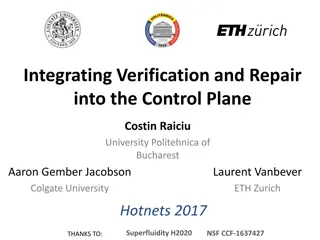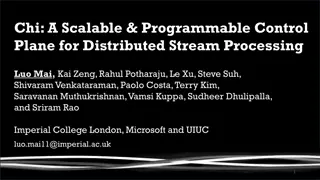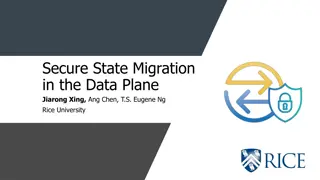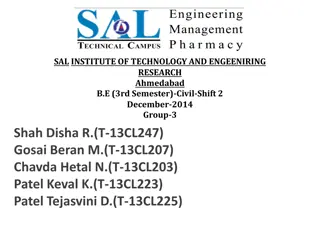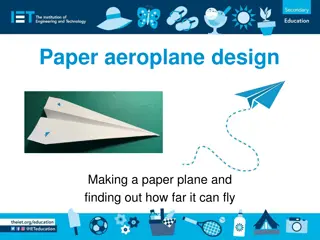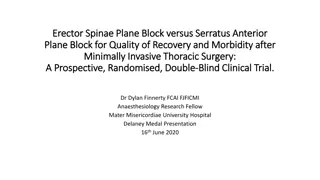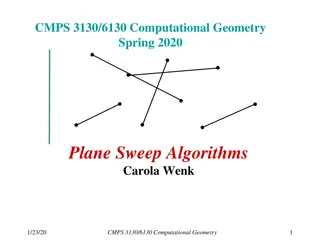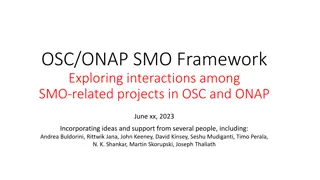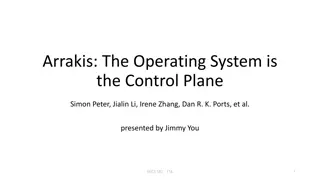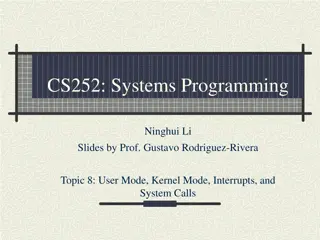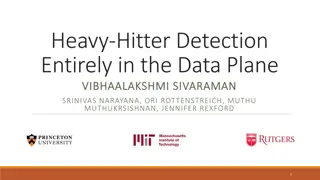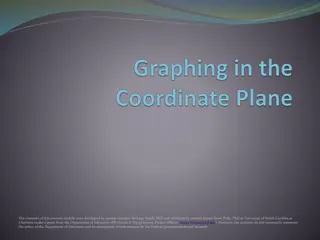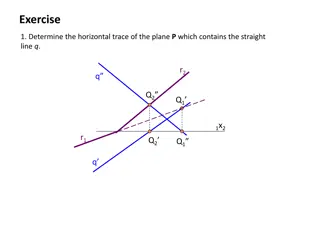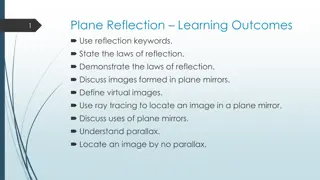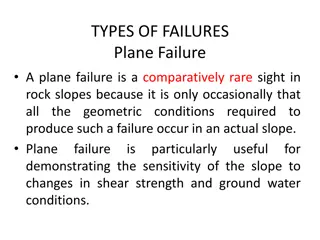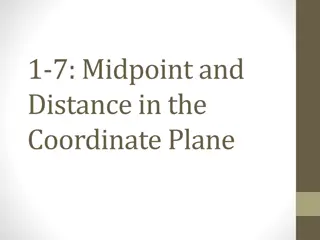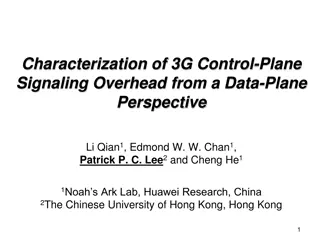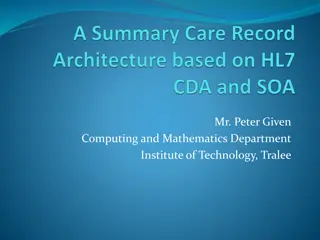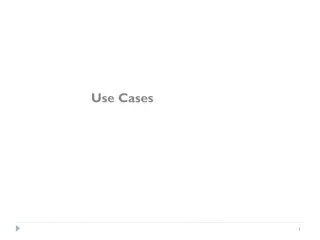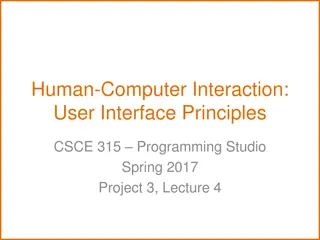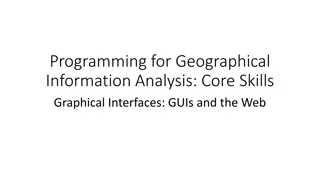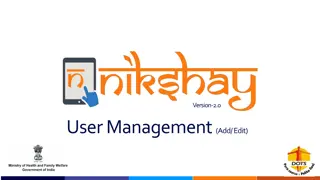Overview of 5G System Architecture and User Plane Functionality
This content showcases various aspects of 5G system architecture, including system handover, non-roaming architecture, service-based architecture, and user plane functionality. It delves into the control plane functions, user plane functions, and core network endpoints of the 5G network. The images provided offer insights into different components and functionalities essential for the efficient operation of a 5G network.
- 5G System Architecture
- User Plane Functionality
- Service-Based Architecture
- Control Plane Functions
- Network Endpoints
Download Presentation

Please find below an Image/Link to download the presentation.
The content on the website is provided AS IS for your information and personal use only. It may not be sold, licensed, or shared on other websites without obtaining consent from the author. Download presentation by click this link. If you encounter any issues during the download, it is possible that the publisher has removed the file from their server.
E N D
Presentation Transcript
Outline 5G System Architecture 5G System Handover
Non-Roaming 5G System Architecture Reference Point Representation
5G Service Based Architecture Control plane function group NSSF NRF PCF UDM AF NEF Npcf Nudm Nnrf Naf Nnssf Nnef Namf Nsmf Nausf AMF SMF AUSF N4 N1 N2 UE (R)AN UPF DN N3 N6 N9 4 User plane function
5G Service Based Architecture User Plane Function (UPF) Control plane function group DN UPF N3 N6 NG Radio Access Network Non-3GPP Access Network (N3IWF functions ) gNodeB UE N9 5 User plane function
User Plane Function (UPF) Functionalities QoS handling for user plane UL/DL rate enforcement, Reflective QoS marking in DL Uplink Traffic verification SDF to QoS Flow mapping Transport level packet marking in the uplink and downlink Downlink packet buffering and downlink data notification triggering Sending and forwarding of one or more "end marker" to the source NG-RAN node ARP proxying and / or IPv6 Neighbour Solicitation Proxying functionality for the Ethernet PDUs The UPF responds to the ARP and / or the IPv6 Neighbour Solicitation Request by providing the MAC address corresponding to the IP address sent in the request Anchor point for Intra-/Inter-RAT mobility When applicable External PDU Session point of interconnect to Data Network Packet routing & forwarding support of Uplink classifier to route traffic flows to an instance of a data network, support of Branching point to support multi-homed PDU Session Packet inspection Application detection based on service data flow template and the optional PFDs received from the SMF in addition User Plane part of policy rule enforcement Gating, Redirection, Traffic steering Lawful intercept UP collection Traffic usage reporting
User Plane Function (UPF) Core Network Endpoints Access Network Edge Network N3 N6 N9 UPF (PSA) DN I-UPF I-UPF : Intermediate PDU PSA : PDU session anchor 7
PDU session N3 N6 DN UPF (PSA) N3 N9 N6 DN I-UPF UPF (PSA) N3 N6 UPF UP CL DN UPF (PSA) 1 N3 N9 N4 N3 N4 N4 I-UPF SMF Uplink data classify by UP CL UPF and forward to difference DN N4 PSA : PDU session anchor I-UPF : Intermediate PDU UP CL : Uplink Classifier N9 N6 DN UPF (PSA) 2
5G Service Based Architecture Session Management Function (SMF) Control plane function group Nsmf SMF N4 DN UPF N3 N6 NG Radio Access Network Non-3GPP Access Network (N3IWF functions ) gNodeB UE N9 9 User plane function
Session Management Function (SMF) Functionalities Session Management Session Establishment, modify and release, including tunnel maintain between UPF and AN node UE IP address allocation & management Including optional Authorization DHCPv4 and DHCPv6 functions Server and client ARP proxying and / or IPv6 Neighbour Solicitation Proxying functionality for the Ethernet PDUs The SMF responds to the ARP and / or the IPv6 Neighbour Solicitation Request by providing the MAC address corresponding to the IP address sent in the request Selection and control of UP function, Including controlling the UPF to proxy ARP or IPv6 Neighbour Discovery, or to forward all ARP/IPv6 Neighbour Solicitation traffic to the SMF, for Ethernet PDU Sessions Configures traffic steering at UPF to route traffic to proper destination Termination of interfaces towards Policy control functions Lawful intercept For SM events and interface to LI System Charging data collection and support of charging interfaces Control and coordination of charging data collection at UPF Termination of SM parts of NAS messages. Downlink Data Notification Initiator of AN specific SM information, sent via AMF over N2 to AN Determine SSC mode of a session. Roaming functionality: Handle local enforcement to apply QoS SLAs (VPLMN). Charging data collection and charging interface (VPLMN). Lawful intercept (in VPLMN for SM events and interface to LI System). Support for interaction with external DN for transport of signalling for PDU Session authorization/authentication by external DN.
5G Service Based Architecture Access and Mobility Management Function(AMF) Control plane function group Namf Nsmf AMF SMF N4 N2 N1 DN UPF N3 N6 NG Radio Access Network Non-3GPP Access Network (N3IWF functions ) gNodeB UE N9 11 User plane function
AMF Access and Mobility Function Access Authentication Access Authorization Provide transport for SMS messages between UE and SMSF Security Anchor Functionality (SEAF) Location Services management for regulatory services Provide transport for Location Services messages between UE and LMF as well as between RAN and LMF EPS Bearer ID allocation for interworking with EPS UE mobility event notification Termination of RAN CP interface (N2) Termination of NAS (N1) , NAS ciphering and integrity protection Registration management Connection management Reachability management Mobility Management Lawful intercept For AMF events and interface to LI System Provide transport for SM messages between UE and SMF Transparent proxy for routing SM messages
5G Service Based Architecture Authentication Server Function (AUSF) Control plane function group Namf Nsmf Nausf AMF SMF AUSF N4 N2 N1 DN UPF N3 N6 NG Radio Access Network Non-3GPP Access Network (N3IWF functions ) gNodeB UE N9 13 User plane function
AUSF Authentication Server Function Implements the EAP authentication server Stores keys
5G Service Based Architecture Network Slice Selection Function (NSSF) Control plane function group NSSF Nnssf Namf Nsmf Nausf AMF SMF AUSF N4 N2 N1 DN UPF N3 N6 NG Radio Access Network Non-3GPP Access Network (N3IWF functions ) gNodeB UE N9 15 User plane function
NSSF Network Slice Selection Function Selecting the set of Network Slice instances serving the UE Determining the Allowed NSSAI and, if needed, the mapping to the Subscribed S-NSSAIs Determining the Configured NSSAI and, if needed, the mapping to the Subscribed S-NSSAIs Determining the AMF Set to be used to serve the UE, or, based on configuration, a list of candidate AMF(s), possibly by querying the NRF
5G Service Based Architecture Network Exposure Function (NEF) Control plane function group NSSF NEF Nnssf Nnef Namf Nsmf Nausf AMF SMF AUSF N4 N2 N1 DN UPF N3 N6 NG Radio Access Network Non-3GPP Access Network (N3IWF functions ) gNodeB UE N9 17 User plane function
NEF Network Exposure Function Exposes capabilities and events Secure provision of information from an external application to 3GPP network Translation of internal/external information Control plane parameter provisioning Packet Flow Description (PFD) management A PFD is a tuple of protocol, server-side IP and port number
5G Service Based Architecture Network Repository Function (NRF) Control plane function group NSSF NRF NEF Nnrf Nnssf Nnef Namf Nsmf Nausf AMF SMF AUSF N4 N2 N1 DN UPF N3 N6 NG Radio Access Network Non-3GPP Access Network (N3IWF functions ) gNodeB UE N9 19 User plane function
NRF NF Repository Function Supports service discovery function Receive NF Discovery Request from NF instance, and provides the information of the discovered NF instances (be discovered) to the NF instance Maintains the NF profile of available NF instances and their supported services
5G Service Based Architecture Policy Control Function (PCF) Control plane function group NSSF NRF PCF NEF Npcf Nnrf Nnssf Nnef Namf Nsmf Nausf AMF SMF AUSF N4 N2 N1 DN UPF N3 N6 NG Radio Access Network Non-3GPP Access Network (N3IWF functions ) gNodeB UE N9 21 User plane function
PCF Policy Control Function Supports unified policy framework to govern network behaviour Provides policy rules to Control Plane function(s) to enforce them Accesses subscription information relevant for policy decisions in a Unified Data Repository (UDR)
5G Service Based Architecture Unified Data Management (UDM) Control plane function group NSSF NRF PCF UDM NEF Npcf Nudm Nnrf Nnssf Nnef Namf Nsmf Nausf AMF SMF AUSF N4 N2 N1 DN UPF N3 N6 NG Radio Access Network Non-3GPP Access Network (N3IWF functions ) gNodeB UE N9 23 User plane function
UDM Unified Data Management Generation of 3GPP AKA Authentication Credentials User Identification Handling Storage and management of SUPI for each subscriber in the 5G system Support of de-concealment of privacy-protected subscription identifier (SUCI) Access authorization based on subscription data Roaming restrictions UE's Serving NF Registration Management Storing serving AMF for UE, storing serving SMF for UE's PDU Session Support to service/session continuity By keeping SMF/DNN assignment of ongoing sessions MT-SMS delivery support. Lawful Intercept Functionality especially in outbound roaming case where UDM is the only point of contact for LI Subscription management SMS management
5G Service Based Architecture Application Function (AF) Control plane function group NSSF NRF PCF UDM AF NEF Npcf Nudm Nnrf Naf Nnssf Nnef Namf Nsmf Nausf AMF SMF AUSF N4 N2 N1 DN UPF N3 N6 NG Radio Access Network Non-3GPP Access Network (N3IWF functions ) gNodeB UE N9 25 User plane function
AF Application Function Application influence on traffic routing Accessing Network Exposure Function Interacting with the Policy framework for policy control Application Functions not allowed by the operator to access directly the Network Functions shall use the external exposure framework via the NEF to interact with relevant Network Functions The functionality and purpose of Application Functions are only defined in this specification with respect to their interaction with the 3GPP Core Network.
Xn based inter NG-RAN handover AMF / UPF AMF / UPF NG NG NG NG NG NG NG NG Xn Xn Xn Without Xn interface Xn Cannot do Xn based handover Xn 29
Xn based inter NG-RAN handover Without UPF re-allocation SMF Hand over a UE from a source NG-RAN to target NG-RAN DN I-UPF UPF AMF Source NG-RAN have Xn connectivity to the target NG-RAN Xn Connectivity AMF is unchanged Target NG-RAN SMF decides to keep the existing UPF and I-UPF Source NG-RAN Handover 30
Xn based inter NG-RAN handover Without UPF re-allocation Source gNB Target gNB UPF UE AMF SMF Handover Preparation Handover Execution Forwarding of data 1. Path Switch Request 2. PDU Session Update Request 3. Session Modification 4a . End marker 4b . End marker 5. PDU Session Update Response 6. Path Switch Response 7. Release Resources 31
Xn based inter NG-RAN handover Without UPF re-allocation (Step 1) Source gNB Target gNB UPF UE AMF SMF Handover Preparation Handover Execution Forwarding of data 1. Path Switch Request 2. PDU Session Update Request N2 Path Switch Request List of PDU Sessions To Be Switched with N2 SM Information Include the list of accepted QoS Flows List of PDU Sessions Rejected with for each PDU Session N2 SM Information including a rejection Cause None of the QoSFlows of a PDU Session are accepted by the Target gNB 3. Session Modification 4a . End marker 4b . End marker Corresponding network slice is not supported in the Target gNB UE Location Information Selected PLMN ID 5. PDU Session Update Response S-NSSAI is introduced as part of the PDU session information 6. Path Switch Response 7. Release Resources 32
Xn based inter NG-RAN handover Without UPF re-allocation (Step 2) Source gNB Target gNB UPF UE AMF SMF Handover Preparation Handover Execution Forwarding of data 1. Path Switch Request 2. PDU Session Update Request 3. Session Modification SMF Services Nsmf_PDUSession_UpdateSMContext Request Inputs PDU Session To Be Switched with N2 SM Information (Secondary RAT usage data, Handover Flag) PDU Sessions Rejected with a rejection Cause UE Location Information UE presence in LADN service area 4a . End marker 4b . End marker 5. PDU Session Update Response 6. Path Switch Response 7. Release Resources 33
Xn based inter NG-RAN handover Without UPF re-allocation (Step 3) Source gNB Target gNB UPF UE AMF SMF Handover Preparation Handover Execution Forwarding of data 1. Path Switch Request 2. PDU Session Update Request 3. Session Modification 4a . End marker Modify N3 tunnel (gNB <-> UPF) 4b . End marker N4 Session Modification Request AN Tunnel Info CN Tunnel Info UPF used for connection to Target gNB and connection to Source gNB CN Tunnel Info (on N3) of UPF need be re-allocated N4 Session Modification Response 5. PDU Session Update Response 6. Path Switch Response 34 7. Release Resources CN Tunnel Info N3 (R)AN tunnel information is released
Xn based inter NG-RAN handover Without UPF re-allocation (Step 4) Source gNB Target gNB UPF UE AMF SMF Handover Preparation Handover Execution Forwarding of data 1. Path Switch Request 2. PDU Session Update Request 3. Session Modification 4a . End marker 4b . End marker 5. PDU Session Update Response UPF sends one or more "end marker" packets for each N3 tunnel on the old path immediately after switching the path 6. Path Switch Response 7. Release Resources The UPF starts sending downlink packets to the Target gNB 35
Xn based inter NG-RAN handover Without UPF re-allocation (Step 5) Source gNB Target gNB UPF UE AMF SMF Handover Preparation Handover Execution Forwarding of data 1. Path Switch Request 2. PDU Session Update Request 3. Session Modification 4a . End marker 4b . End marker SMF Services Nsmf_PDUSession_UpdateSMContext Response 5. PDU Session Update Response Outputs CN Tunnel Info 6. Path Switch Response Used to setup N3 tunnel 7. Release Resources Without including the CN Tunnel Info which user plane resources are deactivated or released 36
Xn based inter NG-RAN handover Without UPF re-allocation (Step 6) Source gNB Target gNB UPF UE AMF SMF Handover Preparation Handover Execution Forwarding of data 1. Path Switch Request 2. PDU Session Update Request 3. Session Modification 4a . End marker 4b . End marker 5. PDU Session Update Response 6. Path Switch Response N2 Path Switch Response N2 SM Information Failed PDU Sessions 7. Release Resources 37
Xn based inter NG-RAN handover Without UPF re-allocation (Step 7) Source gNB Target gNB UPF UE AMF SMF Handover Preparation Handover Execution Forwarding of data 1. Path Switch Request 2. PDU Session Update Request 3. Session Modification 4a . End marker 4b . End marker 5. PDU Session Update Response 6. Path Switch Response Target gNB confirms success of the handover Target gNB triggers the release of resources with the Source gNB 7. Release Resources 38
Xn based inter NG-RAN handover With insertion of intermediate UPF UPF (PSA) DN Hand over a UE from a source NG-RAN to target NG-RAN SMF I-UPF AMF Source NG-RAN have Xn connectivity to the target NG-RAN AMF is unchanged Xn Connectivity SMF decides that insertion of a new additional I-UPF is needed Target NG-RAN Source NG-RAN Handover 39
Xn based inter NG-RAN handover With insertion of intermediate UPF UPF (PSA) new I-UPF Source gNB Target gNB UE AMF SMF Handover Preparation Handover Execution Forwarding of data 1. Path Switch Request 2. PDU Session Update Request 3. I-UPF selection 4. Session Modification 5. Session Establishment 6. Session Modification 7a . End marker 7b . End marker 8. PDU Session Update Response 9. Path Switch Response 10. Release Resources 40
Xn based inter NG-RAN handover With insertion of intermediate UPF (Step 3) UPF (PSA) new I-UPF Source gNB Target gNB UE AMF SMF Handover Preparation Handover Execution Forwarding of data 1. Path Switch Request 2. PDU Session Update Request 3. I-UPF selection 4. Session Modification SMF selects a new UPF to act as intermediate UPF for the PDU Session 5. Session Establishment 6. Session Modification 7a . End marker 7b . End marker 8. PDU Session Update Response 9. Path Switch Response 10. Release Resources 41
Xn based inter NG-RAN handover With insertion of intermediate UPF (Step 4) UPF (PSA) new I-UPF Source gNB Target gNB UE AMF SMF Handover Preparation Handover Execution Forwarding of data 1. Path Switch Request 2. PDU Session Update Request 3. I-UPF selection 4. Session Modification Conditional Different CN Tunnel Info need be used CN Tunnel Info is allocated by the UPF 5. Session Establishment 6. Session Modification Modify and Get N9 tunnel by UPF (UPF <-> UPF) Uplink 7a . End marker N4 Session Modification Request CN Tunnel N4 Session Modification Response CN Tunnel Info UPF (PSA) allocates CN Tunnel Info (on N9) of UPF (PSA) 7b . End marker 8. PDU Session Update Response 9. Path Switch Response 10. Release Resources Provides CN Tunnel Info (on N9) to the SMF 42
Xn based inter NG-RAN handover With insertion of intermediate UPF (Step 5) UPF (PSA) new I-UPF Source gNB Target gNB UE AMF SMF Handover Preparation Handover Execution Forwarding of data 1. Path Switch Request 2. PDU Session Update Request 3. I-UPF selection 4. Session Modification Establish N9 tunnel by UPF(UPF <-> UPF) Uplink and Downlink 5. Session Establishment N4 Session Establishment Request Target gNB Tunnel Info CN Tunnel Info of the PDU Session Anchor (PSA) Used to setup N9 tunnel 6. Session Modification 7a . End marker 7b . End marker If the CN Tunnel Info of the I-UPF is allocated by the SMF, provides the UL and DL CN Tunnel Info of I-UPF to the I-UPF N4 Session Establishment Response CN Tunnel If the CN Tunnel Info of the I-UPF is allocated by the UPF, the UL and DL CN Tunnel Info of I-UPF is sent to the SMF 8. PDU Session Update Response 9. Path Switch Response 10. Release Resources 43
Xn based inter NG-RAN handover With insertion of intermediate UPF (Step 6) UPF (PSA) new I-UPF Source gNB Target gNB UE AMF SMF Handover Preparation Handover Execution Forwarding of data 1. Path Switch Request 2. PDU Session Update Request 3. I-UPF selection 4. Session Modification Modify N9 tunnel by SMF (UPF <-> UPF) Downlink Uplink and Downlink If CN Tunnel Info is allocated by the SMF (without Step 4) 5. Session Establishment 6. Session Modification N4 Session Modification Request DL CN Tunnel Info of the I-UPF UL CN Tunnel Info N4 Session Modification Response 7a . End marker 7b . End marker 8. PDU Session Update Response 9. Path Switch Response PDU Session Anchor starts sending downlink packets to the Target gNB via I-UPF 10. Release Resources 44
Xn based inter NG-RAN handover With re-allocation of intermediate UPF Source I-UPF Hand over a UE from a source NG-RAN to target NG-RAN SMF UPF (PSA) DN Target I-UPF AMF Source NG-RAN have Xn connectivity to the target NG-RAN AMF is unchanged Xn Connectivity SMF decides that the I-UPF is to be changed Target NG-RAN Source NG-RAN Handover 45
Xn based inter NG-RAN handover With re-allocation of intermediate UPF Source I-UPF UPF (PSA) Target I-UPF SMF / vSMF Source gNB Target gNB hSMF UE AMF Handover Preparation Handover Execution Forwarding of data 1. Path Switch Request 2. PDU Session Update Request 3. I-UPF selection 4. Session Modification 5. Session Establishment 6. Session Modification 7. PDU Session Update 8a . End marker 9b . End marker 10. PDU Session Update Response 11. Path Switch Response 12. Release Resources 13. Session Release 46
Xn based inter NG-RAN handover With re-allocation of intermediate UPF (Step 6, 7) Source I-UPF UPF (PSA) Target I-UPF SMF / vSMF Source gNB Target gNB hSMF UE AMF Handover Preparation Handover Execution Forwarding of data 1. Path Switch Request 2. PDU Session Update Request 3. I-UPF selection 4. Session Modification 5. Session Establishment Re-allocation of UPF (Non-roaming and Roaming with Local Breakout ) Do step 6 and skip step 7 SMF send Session Modification to modify the PDU Session Modify N9 tunnel Re-allocation of vUPF (In case of home routed roaming) Do step 7 and skip step 6 UPF (PSA) allocate at HPLMN 6. Session Modification 7. PDU Session Update 8a . End marker 9b . End marker 10. PDU Session Update Response 11. Path Switch Response 12. Release Resources vSMF sent PDU Session Update to notify the hSMF to modify PDU Session 13. Session Release 47
Xn based inter NG-RAN handover With re-allocation of intermediate UPF (Step 13) Source I-UPF UPF (PSA) Target I-UPF SMF / vSMF Source gNB Target gNB hSMF UE AMF Handover Preparation Handover Execution Forwarding of data 1. Path Switch Request 2. PDU Session Update Request 3. I-UPF selection 4. Session Modification 5. Session Establishment 6. Session Modification 7. PDU Session Update The timer is started in step 5 if the source UPF is not the PSA UPF When this timer is expired, the SMF initiates Source UPF Release procedure 8a . End marker 9b . End marker 10. PDU Session Update Response 11. Path Switch Response N4 Session Release Request 12. Release Resources Release Cause N4 Session Release Response 13. Session Release 48
Reference - Network Slicing TS 23.501 System architecture for the 5G System (5GS) TS 23.502 Procedures for the 5G System (5GS) TS 29.244 Interface between the Control Plane and the User Plane nodes 3GPP SA2_121



